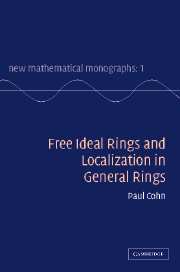Book contents
- Frontmatter
- Contents
- Preface
- Note to the reader
- Terminology, notation and conventions used
- List of special notation
- 0 Generalities on rings and modules
- 1 Principal ideal domains
- 2 Firs, semifirs and the weak algorithm
- 3 Factorization in semifirs
- 4 Rings with a distributive factor lattice
- 5 Modules over firs and semifirs
- 6 Centralizers and subalgebras
- 7 Skew fields of fractions
- Appendix
- Bibliography and author index
- Subject Index
0 - Generalities on rings and modules
Published online by Cambridge University Press: 22 August 2009
- Frontmatter
- Contents
- Preface
- Note to the reader
- Terminology, notation and conventions used
- List of special notation
- 0 Generalities on rings and modules
- 1 Principal ideal domains
- 2 Firs, semifirs and the weak algorithm
- 3 Factorization in semifirs
- 4 Rings with a distributive factor lattice
- 5 Modules over firs and semifirs
- 6 Centralizers and subalgebras
- 7 Skew fields of fractions
- Appendix
- Bibliography and author index
- Subject Index
Summary
This chapter collects some facts on rings and modules, which form neither part of our subject proper, nor part of the general background (described in the Appendix). By its nature the content is rather mixed, and the reader may well wish to begin with Chapter 1 or even Chapter 2, and only turn back when necessary.
In Section 0.1 we describe the conditions usually imposed on the ranks of free modules. The formation of matrix rings is discussed in Section 0.2; Section 0.3 is devoted to projective modules and the special class of Hermite rings is considered in Section 0.4.
Section 0.5 deals with the relation between a module and its defining matrix, and in particular the condition for two matrices to define isomorphic modules. This and the results on eigenrings and centralizers in Section 0.6 are mainly used in Chapters 4 and 6.
The Ore construction of rings of fractions is behind much of the later development, even when this does not appear explicitly. In Section 0.7 we recall the details and apply it in Section 0.8 to modules over Ore domains; it turns out that the (left or right) Ore condition has some unexpected consequences. In Section 0.9 we recall some well-known facts on factorization in commutative rings, often stated in terms of monoids, in a form needed later.
Rank conditions on free modules
Let R be any ring, M an R-module and I a set.
- Type
- Chapter
- Information
- Free Ideal Rings and Localization in General Rings , pp. 1 - 59Publisher: Cambridge University PressPrint publication year: 2006



